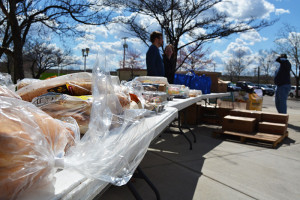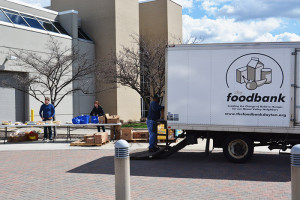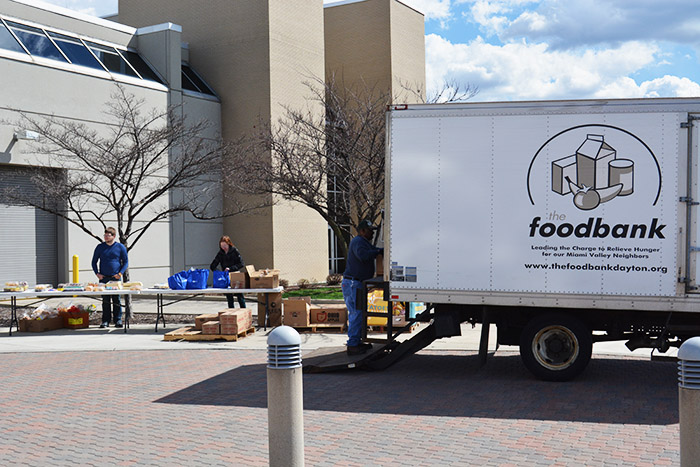 Half of all community college students in the U.S. are facing food or housing insecurity, or a combination of both. According to a recent ACCT (Association of Community College Trustees) survey stated, “—20 percent [of undergraduates] are hungry and 13 percent are homeless.” Dayton is even in the top 10 hungriest cities in the U.S.
Half of all community college students in the U.S. are facing food or housing insecurity, or a combination of both. According to a recent ACCT (Association of Community College Trustees) survey stated, “—20 percent [of undergraduates] are hungry and 13 percent are homeless.” Dayton is even in the top 10 hungriest cities in the U.S.
Everyone experiences hunger, but what happens if that were to become routine?
You’re late for morning classes and don’t eat breakfast, you also forgot to bring a lunch today. You’re saving money, so you’ll wait until you get home for dinner. When you arrive home, you only have a small portion of food. This happens for days, the same thing over and over. In a couple of days, you begin to grow more tired; you feel drowsy and weak. You have less energy to focus on school, your work, etc. After a week, lightheadedness is commonplace and you always feel drained.
According to the Food Research and Action Center (FRAC), “At first, the relationship between food insecurity and obesity was considered counterintuitive and labeled a paradox. This was due, in part, to our limited understanding of the causes and consequences of food insecurity.”
Food insecurity is a state in which consistent access to adequate food is limited by a lack of money and other resources at times during the year. FRAC later explained how when someone lives in a “food desert,” they can be deprived of a nutritionally balanced diet. That would mean that their only access to food is either fast food restaurants or even just a gas station. When someone lives in an inner city with no car, that would mean that their food can often come from the closest provider within their walking distance.
Nora Schaefer, Dietary Managers Program Director and Professor said that a nutritionally balanced diet is what many hungry people lack. That’s usually due to the fact that healthier food options tend to be more expensive which is why we see the obese hungry in the U.S. The reason why we see hunger in people who still work and go to school is because of the “working poor,” that refers to people who can only just afford enough food to not completely starve, but that’s where they lack a nutritional diet.
The above examples are two forms of hunger that half of community college kids are experiencing, not a simple rumbling stomach. That means that there is a fifty-fifty chance that the student next to you in class is experiencing food insecurity. How is this being addressed? What can someone do about it? Is anyone currently helping to solve this?
One way of helping is the Dayton Mobile Food Pantry, which comes to Sinclair once a month—September through April—to Building 20 to provide a balanced meal to those who need it most.
If you’re a current student, bring your Tartan ID card to the Dayton Mobile Food Pantry. People are welcome to volunteer to hand assist in any way with the project. The last time the truck came was Thursday, March 17. The next time the truck returns will be April 21.
Schaefer said, “Even Tony Hall said this [during the REACH event]. We have enough food—it’s just that… the issue is, individuals aren’t getting to their resources or we’re not distributing it correctly which is troubling… really troubling.”
Schaefer continued, “And he said that we have the food, but are we getting the word out there?”
 Schaefer plans on working with academic advisors and professors alike to provide a miniature survey to discover if the student faces food insecurity or not. If they answer “yes” to any of the questions, it provides information on the back on how to register for the Dayton Mobile Food Pantry.
Schaefer plans on working with academic advisors and professors alike to provide a miniature survey to discover if the student faces food insecurity or not. If they answer “yes” to any of the questions, it provides information on the back on how to register for the Dayton Mobile Food Pantry.
She explained that it was her hope that Sinclair could secure a food pantry. However, there have been setbacks. Schaefer said it’ll be an issue to come back to at a later date. However, she said the issue of hunger can’t wait any longer.
During the REACH event last month, keynote speaker Tony Hall spoke of The Good Samaritan law. That law is in place to offer legal protection to people who give reasonable assistance to those who are injured, ill, in peril, or otherwise incapacitated. That includes food donation. It’s Schaefer’s hope that the “The Good Samaritan” law can help her group in creating a food pantry at Sinclair one day.
Schaefer said a project called Lunchtime Hunger is being sponsored by the Dietetics, Hospitality and Social Work student clubs. This project bypasses the legal bindings of a food pantry contract since it’s provided through a club; they will begin passing out a nutritional meal several times a week. It’s scheduled to take place at the end of March, 2016.
This project will be provided Tuesdays, Wednesdays and Thursdays from 11:00 a.m. to 2:00 p.m., where the goal is to service those who need it most. Schaefer plans for this project to resemble the Dayton Mobile Food Pantry by people simply need their Tartan ID cards to register to receive the food. People can also bring a referral card provided at the Dayton Mobile Food Pantry, Academic Advising, Student Affairs and the Dietetics and Nutrition Department.
The plan, according to Schaefer, is to really jump start this project by spreading the word through these departments that see the largest amount of students on a regular basis. The project is set to be hosted in Building 13, room 426.
Schaefer said the food is prepared in the Sinclair culinary kitchen under strict safety-food protocol guidelines. She said it is more difficult to provide perishables since they expire more easily; however, the point is that perishables are nutritional and tend to be healthier, so it’s worth the longer time of preparation. This project is directed at reducing the percentage of students at Sinclair who are going hungry. She said this project has gone through revision and was planned and budgeted to endure the next two years.
This project is a way to address the hunger seen on campus. Schaefer noted, “And of course, this wouldn’t be possible without Kathy Rowell, she’s the one to really push for this. I have to give kudos to her.”
What can someone do to help or contribute? There are a number of ways to become involved in this project and in helping to solve hunger. One way is to donate money to the Dayton Food Pantry or to House of Bread. Another way to take part to contribute, according to Schaefer is taking part in what’s called the Food Stamp Challenge.
The point of the challenge is that for one week, a person will live on the food budget of the average food stamp recipient—about $4.00 a day—and the money saved from that challenge is then donated to a foodbank of your choice. Every dollar donated to Foodbank Inc. provides four meals.
Other ways to get involved are volunteering for the monthly food truck, search for organizations in Dayton like Homefull, House of Bread, the Dayton Foodbank, or host a meal at a soup kitchen. There are people out there in the world that need aid, according to Schaefer, there is hope.Will you be one to fight against the injustice, or not?
For more information about becoming involved with these upcoming projects or if you are in need, email Nora Schaefer at nora.schaefer@sinclair.edu or contact her at (937)-512-5168.
Ehron Ostendorf
Copy Editor

